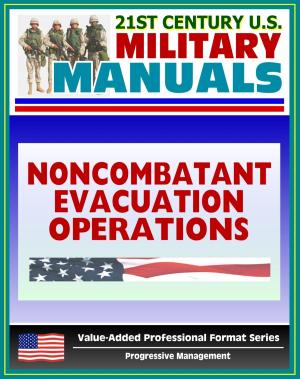On the Far Bank: The Effects of Gap Crossing on Operational Reach - Studies of Three Large-scale, Opposed River Crossings in World War II and Arab-Israeli War: Operations Market Garden, Plunder, Badr
Nonfiction, History, Military, United States, World War II| Author: | Progressive Management | ISBN: | 9781370886678 |
| Publisher: | Progressive Management | Publication: | January 30, 2017 |
| Imprint: | Smashwords Edition | Language: | English |
| Author: | Progressive Management |
| ISBN: | 9781370886678 |
| Publisher: | Progressive Management |
| Publication: | January 30, 2017 |
| Imprint: | Smashwords Edition |
| Language: | English |
This excellent report has been professionally converted for accurate flowing-text e-book format reproduction. Throughout history, opposed river crossing operations have proven to be some of the bloodiest and most complex endeavors for any military force. However, due to a sixty-year lull in having to cross a river in the face of the enemy, the United States Army has shown a trend of diminishing its resource capacity necessary to conduct these crossings, and is losing doctrinal focus for the task. Most significantly, doctrine does not provide an appreciation for the large impacts a river crossing has on the remainder of an operation. This analysis looks at three large-scale, opposed river crossing operations in the mechanized warfare era. All three cases involve a successful opposed river crossing, but vary in the level of operational reach or time before culmination. The variance in each case stems from the preparation for and execution of the river crossing. The analysis identifies three elements that had the greatest impact on the operational reach of units after the river crossing: the rapid employment of overwhelming strength, a deliberate plan to provide assault crossing resources regardless of existing bridges, and a detailed plan that included the transition from bridgehead to breakout operations.
The recorded history of ground combat has shown that river crossing operations have always been a focal point for planners. The great military thinker Carl von Clausewitz himself devoted a chapter of his masterpiece On War to this subject. In it, he referred to the "respect in which an attack on a defended river is held by most generals." While evidence in past military theory and history repeatedly demonstrated the importance of this tactical task, the recent history of the United States Army reveals a decrease in the frequency of attacks over well-defended rivers. The United States Army has not conducted an opposed, deliberate wet gap crossing since World War II.
Future combat operations, however, could require gap crossings and the Army must remain proficient in planning for and conducting them. Rivers that would require non-hasty crossing methods exist in every geographic region, meaning that any future Army operation against a conventional force could require a deliberate gap crossing. History demonstrates the importance of the tactical task of gap crossing to overall mission accomplishment. Some of the most successful gap crossings in history involved entire armies of multiple corps focused on nothing but establishing a bridgehead, as with the spring 1945 Rhine crossing's in World War II and Operation Badr in the Arab-Israeli War. History also demonstrates that operations can fail in spite of a successful gap crossing. The Allied failure in Operation Market-Garden during World War II showed that successfully crossing a river such as the Waal does not necessarily lead to operational success. If in planning and execution, commanders and their staffs do not integrate the gap crossing with other tactical actions effectively, the operation may culminate earlier than expected.
Despite historical evidence that demonstrates the challenges associated with gap crossings, after a seventy-year lull in US experience with opposed crossings the United States Army gradually diminished its efforts to prepare for gap crossing operations. Army leaders reduced the number of units and associated equipment that specialize in gap crossing. Most recently, they approved updated doctrine that relegates gap crossing—once the topic of a dedicated field manual—to a single chapter of the 2011 Combined Arms Mobility manual. Training centers have noted that current units struggle to plan and execute gap crossing operations.
This excellent report has been professionally converted for accurate flowing-text e-book format reproduction. Throughout history, opposed river crossing operations have proven to be some of the bloodiest and most complex endeavors for any military force. However, due to a sixty-year lull in having to cross a river in the face of the enemy, the United States Army has shown a trend of diminishing its resource capacity necessary to conduct these crossings, and is losing doctrinal focus for the task. Most significantly, doctrine does not provide an appreciation for the large impacts a river crossing has on the remainder of an operation. This analysis looks at three large-scale, opposed river crossing operations in the mechanized warfare era. All three cases involve a successful opposed river crossing, but vary in the level of operational reach or time before culmination. The variance in each case stems from the preparation for and execution of the river crossing. The analysis identifies three elements that had the greatest impact on the operational reach of units after the river crossing: the rapid employment of overwhelming strength, a deliberate plan to provide assault crossing resources regardless of existing bridges, and a detailed plan that included the transition from bridgehead to breakout operations.
The recorded history of ground combat has shown that river crossing operations have always been a focal point for planners. The great military thinker Carl von Clausewitz himself devoted a chapter of his masterpiece On War to this subject. In it, he referred to the "respect in which an attack on a defended river is held by most generals." While evidence in past military theory and history repeatedly demonstrated the importance of this tactical task, the recent history of the United States Army reveals a decrease in the frequency of attacks over well-defended rivers. The United States Army has not conducted an opposed, deliberate wet gap crossing since World War II.
Future combat operations, however, could require gap crossings and the Army must remain proficient in planning for and conducting them. Rivers that would require non-hasty crossing methods exist in every geographic region, meaning that any future Army operation against a conventional force could require a deliberate gap crossing. History demonstrates the importance of the tactical task of gap crossing to overall mission accomplishment. Some of the most successful gap crossings in history involved entire armies of multiple corps focused on nothing but establishing a bridgehead, as with the spring 1945 Rhine crossing's in World War II and Operation Badr in the Arab-Israeli War. History also demonstrates that operations can fail in spite of a successful gap crossing. The Allied failure in Operation Market-Garden during World War II showed that successfully crossing a river such as the Waal does not necessarily lead to operational success. If in planning and execution, commanders and their staffs do not integrate the gap crossing with other tactical actions effectively, the operation may culminate earlier than expected.
Despite historical evidence that demonstrates the challenges associated with gap crossings, after a seventy-year lull in US experience with opposed crossings the United States Army gradually diminished its efforts to prepare for gap crossing operations. Army leaders reduced the number of units and associated equipment that specialize in gap crossing. Most recently, they approved updated doctrine that relegates gap crossing—once the topic of a dedicated field manual—to a single chapter of the 2011 Combined Arms Mobility manual. Training centers have noted that current units struggle to plan and execute gap crossing operations.















